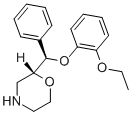Other grades of this product :
| Reboxetine Basic information |
| Product Name: | Reboxetine | | Synonyms: | REBOXETINE;(2R)-2-[(R)-(2-Ethoxyphenoxy)phenylmethyl]morpholine;Reboxetine Impurity 1;Reboxetine USP/EP/BP | | CAS: | 98769-81-4 | | MF: | C19H23NO3 | | MW: | 313.39 | | EINECS: | | Product Categories: | Inhibitor | | Mol File: | 98769-81-4.mol |
| Reboxetine Chemical Properties |
| Reboxetine Usage And Synthesis |
| Description | Reboxetine is a pure noradrenaline reuptake inhibitor that is licensed as an antidepressant in the United Kingdom. Reboxetine has established efficacy based on placebo-controlled studies both in the short and the long term. Previous noradrenaline reuptake inhibitors, such as desipramine, nortriptyline, and maprotiline, have been relatively selective for noradrenaline compared with serotonin but have not avoided affinities with α1, muscarinic, and histaminergic receptors. The lack of selectivity of these drugs has the consequence that the levels of cardiotoxicity are those expected with TCAs. Reboxetine is the first pure noradrenaline reuptake inhibitor, and therefore it may also provide a more appropriate agent to consider for the investigation of possible adjunctive treatments with SSRIs. | | Uses | Reboxetine can be used in biological study of the involvement of monoaminergic neurotransmission in the antidepressant-like action of scopolamine in the tail suspension test. | | General Description | Most of the activity of reboxetine resides in the S,S-isomer(The marketed compound is RR and SS.) It is claimed to besuperior to fluoxetine in severe depression. It is marketed inEurope. At least three tricyclic compounds, desipramine,nortriptyline, and the technically tetracyclic maprotiline areSNERIs. They, of course, have typical characteristic TCAside effects but lower anticholinergic and H1-antihistaminic(sedative) effects than dimethyl compounds. SNERIs areclinically effective antidepressants.It would be expected that in the case of SNERIs,α2presynaptic receptors would be desensitized, after whichsustained NE transmission would be via one or more postsynapticreceptors; α1, β1, and β2 receptors are possibilities. | | Clinical Use | Reboxetine is a nontricyclic SNRI in which the propylamine side chain of the TCAs is constrained into a
morpholine ring. It is a potent and selective ligand for the NET, with a mechanism of action is
similar to that of desipramine. Reboxetine is used for the treatment of major depressive disorders. It is a
chiral compound that is marketed as a racemic mixture of R,R- and S,S-reboxetine. The antidepressant
activity for reboxetine appears to reside with the S,S-(+)-enantiomer, which has approximately twofold the
inhibition potency of the R,R-enantiomer. It is well tolerated, with different adverse-event profiles, and it
appears to be at least as effective as the SSRIs in the treatment of depressive illness. Currently, it is
available only in Europe and is under U.S. FDA review. It preferentially inhibits the reuptake of NE (5-HT :NE
ratio, 8). Reboxetine is not metabolized by the polymorphic isoforms, CYP2D6 or CYP2C19, and may offer a
valuable alternative to the secondary amine TCAs in the treatment of major depression. Reboxetine is likely
to become a promising alternative for patients who have failed treatment with or do not tolerate serotonergic
antidepressants. | | Side effects | Reboxetine is relatively well tolerated, with insomnia, sweating, constipation, and dry mouth being commonly
reported adverse events. Hypotension and urinary hesitancy occur at lower rates than with the TCAs. When
compared with the SSRIs, reboxetine is associated with lower rates of nausea, somnolence, and diarrhea. | | Drug interactions | Reboxetine seems to be an antidepressant that has negligible interference with the pharmacokinetics of other
drugs; thus, fewer drug–drug interactions are expected. It also may be possible to use reboxetine in
combination with MAOIs, because it has no inhibitory effect on this enzyme, which would avoid tyramineinduced hypertensive reactions. | | Metabolism | Reboxetine is predominantly metabolised in vitro via
cytochrome P4503A (CYP3A4); the main metabolic
pathways identified are dealkylation, hydroxylation, and
oxidation followed by glucuronide or sulfate conjugation.
Elimination is mainly via urine (78%) with 10% excreted
as unchanged drug. |
| Reboxetine Preparation Products And Raw materials |
|
